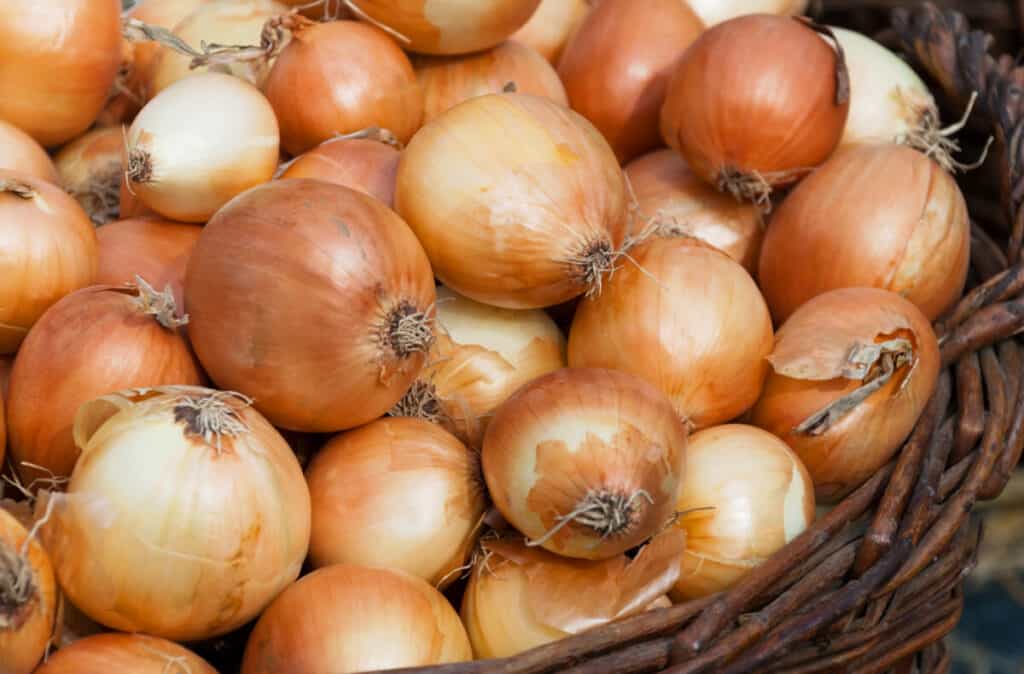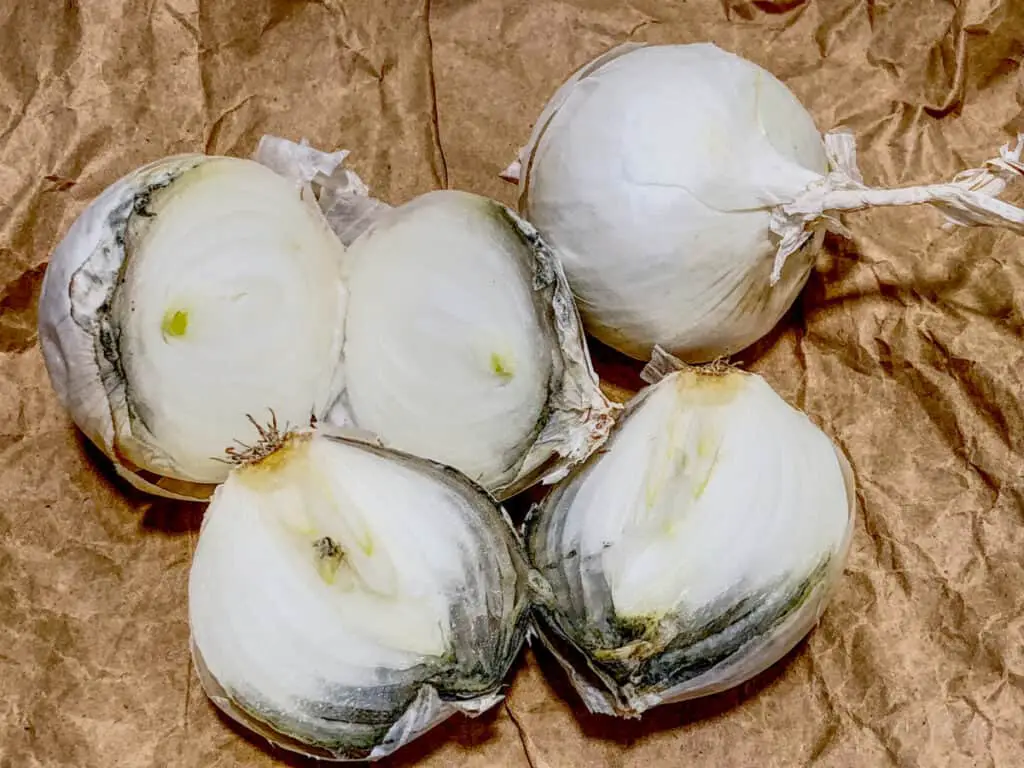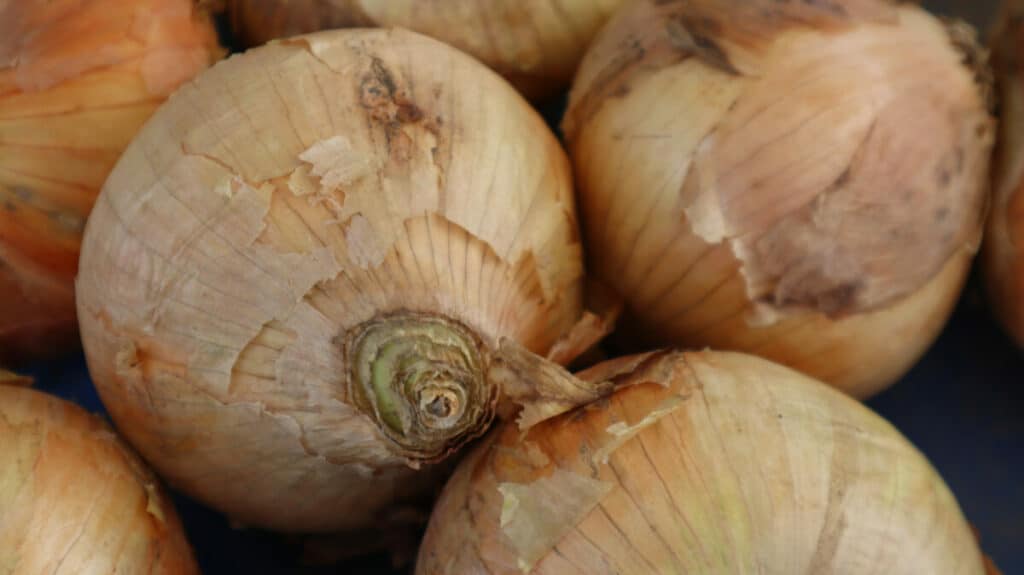This post contains affiliate links.
If you like to cook like me, you go through onions like they’re going out of style. It seems like almost every savory recipe calls for an onion so they’re a staple in my house. But every once in a while I’ll find an onion that’s no good anymore so I’ll chuck it. This made me wonder how long do onions last at room temperature?
Raw onions will last 2-3 months at room temperature if stored correctly. A cool, dry room with good ventilation will keep onions fresh for several months. Store clean, raw onions separately from other vegetables. Ensure that the temperature of the room stays between 40-50 degrees Fahrenheit.
Because onions last a long time in storage and can be grown nearly anywhere, onions are a staple in many households. They add flavor to dishes and can be eaten raw, cooked, sauteed, boiled, or pickled.
Onions are also a nutrient-rich food. Onions contain no cholesterol, sodium, or fat, with only 64 calories per cup. They’re also high in Vitamin C and folic acid. They also contain quercetin, an antioxidant known to combat cataracts, cancer, and cardiovascular diseases.
Proper Onion Storage
Proper onion storage requires carefully creating a good storage area. First, the onions must be clean and free from imperfections that might compromise long-term storage. Dirt, sprouts, or softness can lead to rotten onions. Thin skin or skin damage will shorten the life span of stored onions. Store onions whole and raw. Leave the skin on and the bulb intact. If the onion is cut, it will need to be stored in the refrigerator.
Second, onions must have good ventilation to stay fresh. The storage area should be properly ventilated, allowing air to circulate freely. Onions should be stored in a basket, open paper bag, or mesh bag. Do not store onions in a plastic bag, as they will not have proper ventilation and will grow moldy.

Third, the humidity in the storage area should be low and stable. The temperature should stay the same as well. Around 40-50 degrees Fahrenheit is the ideal temperature, which is lower than a usual kitchen temperature but warmer than a refrigerator. Onions that are stored in changing temperature and humidity will either rot or grow sprouts.
Lastly, onions should be stored by themselves. Try to keep onions from touching each other. If this is not an option, then at least avoid storing onions with potatoes. Potatoes and onions give off fumes that encourage other fruits and vegetables to ripen. Both are best stored separately.
If the ideal storage area isn’t available, don’t worry. Onions will stay fresh in the kitchen pantry for about 4-6 weeks if kept at room temperature. Onions left on the kitchen counter or in a fruit bowl will stay fresh for 1-2 weeks.
Storage Tips and Tricks
While baskets and mesh bags are most commonly used for storing onions, there are other options. Use an old pair of pantyhose to make a hanging onion bag. Drop one onion into the panty hose and tie a knot about an inch above the onion.
Repeat the process until the pantyhose are filled to the top. Hang in a cool, dry storage area. To use one, cut a hole in the pantyhose and push out the onion. Start at the bottom of the pantyhose and work towards the top. Onions stored in pantyhose will be properly ventilated and kept separately from other vegetables.
To make onions last even longer, consider pickling them. Pickled onions can be used in salads, sandwiches, tacos, coleslaw, and even on hot dogs as an alternative to relish. The pickling process is quite easy.
Combine 1 cup vinegar, two tablespoons of sugar, and a teaspoon of salt. Slice up one large onion and put it in a jar, filling the jar to the top with the vinegar mixture. Increase the recipe measurements to pickle more onions.
Once the jars are filled, they can be stored in several ways. Stored with a tight lid in the refrigerator, pickled onions will last a couple of weeks. If vacuum-sealed, pickled onions can last over two years in food storage at room temperature. After opening, store in the fridge and use within a week.
Another option for room temperature onion storage is dehydration. Chop the onions into small pieces. Using a dehydrator set to at least 125 degrees Fahrenheit, dehydrate for at least 8 hours. Store dehydrated onions in air-tight glass jars in a cool, dry place.
How to Tell If Onions Are Spoiled or Rotten

Spoiled or rotten onions will look, smell, and feel different from fresh onions. Onions usually have a pungent smell, but rotten onions will smell even more pungent. If you’re used to the smell of fresh onions, the smell of rotten onions will be strange and awful. If an onion smells worse than normal, don’t use it.
Fresh onions will be the same color all over. Rotten or spoiled onions will often have spots. These spots can be black, brown, or a gray-ish version of the original color of the onion. If an onion has developed a darker skin all over, the onion is still okay to eat. Darkening of the outer layer of skin is normal, as long as the entire onion skin is darker.
Rotten or spoiled onions will usually have soft spots as well. These spots are like the bruises commonly found on apples and bananas. Fresh onions will be firm all over and shouldn’t give when squeezed. Soft spots are prone to growing mold. However, onions with soft spots but no dark spots or mold can still be used. Cut out the soft spot and the area around it, checking for other spots. The onion should be used immediately.
Moldy onions will have dark spots. They will commonly have a dark, sooty mold growing if they have gone bad. This mold is called Aspergillus Niger. If the mold has only spread on the outer layer of the onion and the inside is firm, the onion is okay to use. Simply remove the outer layer, rinse well, and cook.
Sometimes, onions will start to sprout little green tendrils. While this isn’t ideal, the onions haven’t gone bad. Their freshness and flavor may be different from when they were first picked. Cut off the sprouts and use the onion normally.
You can even replant an onion that has sprouted. It won’t produce more onions, but it will grow onion sprouts. The sprouts can be used for cooking.
Growing Onions for Storage
Onions are an easy crop to care for, and can be grown anywhere in the United States. For those who want to start growing their own food, onions are a good place to begin.
Onions are usually grown from onion sets. These can be purchased at the garden store, online, or grown from seed yourself. Starting with seeds isn’t recommended for new gardeners, but starting with onion sets is easy. The onion sets should be a little less than an inch in diameter.
Do some reading about your area before ordering your onion sets. Depending on your climate, onions will need to be planted at different times during the year. Use an almanac or gardening book to determine your climate and growing season.
Choose which type of onions to plant. Common and easy-to-grow varieties include yellow, white, and purple. Sweeter onions will not last as long in storage as pungent ones. Plan to eat the sweeter ones first. Plant more pungent onions for a large crop to store long-term.
Onions need a lot of sunshine, plenty of space, and good nutrition to grow. A place with direct sunlight, away from other plants, is best for planting.
Plant the onions in rows with several inches of space between each bulb. Cover the bulbs with a thin layer of soil. The bulbs shouldn’t be planted deeper than one inch under the soil.
Onions usually don’t need to be watered except in a drought. Spreading hay or mulch around the bulbs helps keep in moisture. The more water an onion has, the sweeter it will be.
Prepping Onions for Storage
If you bought your onions from the grocery store, you won’t need to do much prepping before storing them. Home-grown onions do require some preparation for long-term storage.
Harvest your onions by late summer. When the leaves turn yellow and fall over, the onions are nearly ripe. Stomp on the leaves to encourage the onions to ripen. Gently stir up the soil around the bulb. Loosening the soil helps the onion dry and prevents mold.
When the leaves turn brown, the onions are ready to harvest. Carefully pull the onion out of the ground by its stem, making sure not to bruise or break the skin. If you do bruise or break the skin, eat the onion in the next few days instead of storing it.
Cut off the roots and the stems, leaving an inch of stem on top of the onion. Leave the onions to dry for a few days. If the weather is dry, outside is fine. If not, leave them in a garage or barn to dry.
After drying, store the onions the same way as store-bought onions. One option for storing home-grown onions is braiding the stems together. To do this, leave the stems on the onions after harvesting and allow them to dry. Braid the stems together, leaving the onions in a clump at the bottom. Hang the braid in the storage area. To use one, simply pluck an onion from the braid.

Other Ways to Use Your Onions
Onions have been used for centuries as a cure for ailments. Rubbing raw onion on a spider bite or bee sting takes away the pain and itching.
Slice an onion in half and rub the inside on a rusty knife. The rust will break down from chemicals in the onion and should come off clean after a wash. Washing any metal utensil with onion will keep it from rusting and restore shine.
Use onion extract on your hair for healthy, shiny hair. Add a bit of the extract to your shampoo, leave it on for several minutes, and rinse. In small amounts, you shouldn’t be able to notice the smell of onions. Stop using onion extract if you notice skin irritations.

Onion extract can be used to make hair grow, stop gray hairs from turning gray, and to repel dandruff. Mix it with coconut oil or honey and leave it on the scalp for at least twenty minutes. Rinse, and repeat once or twice a week.
Putting half an onion in a container with avocado will keep it from going brown. Store in the refrigerator. Make sure the container is airtight and the inside of the onion is exposed to the air.
Onions can also help get rid of the smell of paint. Cut an onion in half and place it in a bowl in the room that has been painted. After a few hours, the paint smell should be gone.
Purple onions can be used to dye fabrics. Depending on the fabric type, the dye will turn the fabric red, purple, brown, or green. Keep the outer skins of your onions for dye as a natural alternative to chemical dyes. You can even use onion skins to dye Easter eggs!
Leaving some grated onion on a shirt before washing it can get rid of stains. This works especially well for scorch stains from an iron.
Another natural alternative made from onions is a pesticide. Blend onions, garlic, and water in a blender. Dissolve soap into a bucket of water, and add the mixture from the blender. Spray the mixture on plants to get rid of pests and keep plants healthy.
This natural pesticide can repel ants, but a stronger solution may be required. Slice up an onion and place in a bowl. Leave the bowl in problem areas where ants are an issue.
Use half an onion to clean burnt bits off your grill. Heat up the grill to soften the burnt bits. Wait until the grill is warm, not hot, and rub the onion on any burnt bits. The chemicals in the onion should break down anything burnt and any bits will be easy to wipe off.
The same process can be used for washing pots and pans. Rub the onion onto the pot or pan before washing. Let it soak with water and soap, then scrub.



